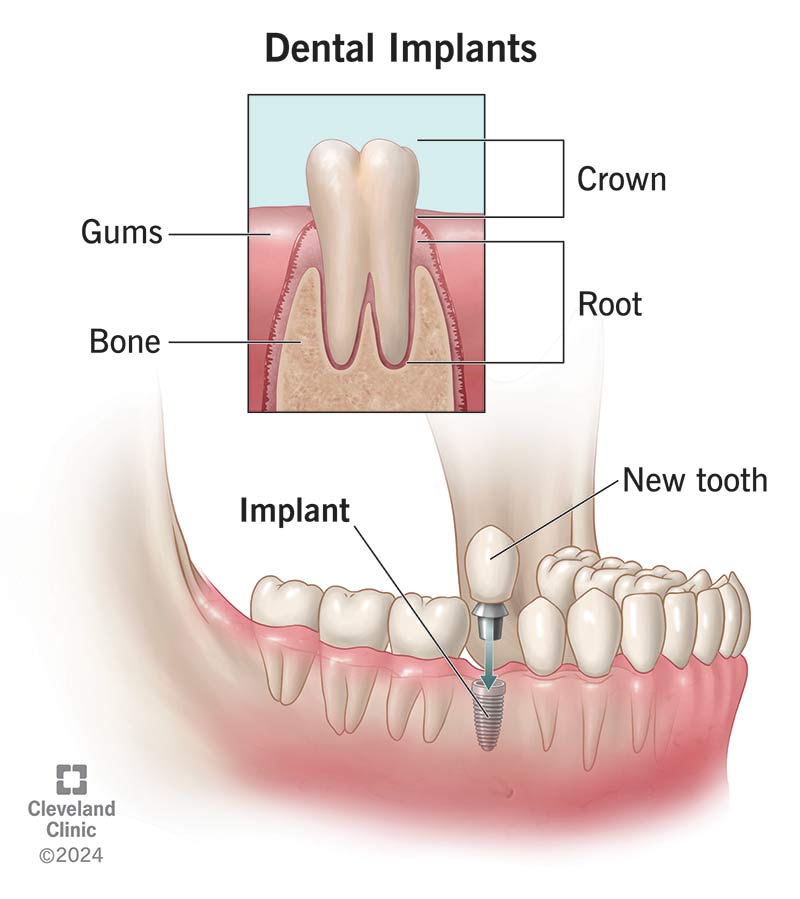Little Known Facts About Dental Implants.
Little Known Facts About Dental Implants.
Blog Article
The 7-Minute Rule for Dental Implants
Table of ContentsRumored Buzz on Dental ImplantsDental Implants for BeginnersThe Single Strategy To Use For Dental ImplantsRumored Buzz on Dental Implants
are medical tools surgically dental implanted into the jaw to recover a person's capacity to chew or their look. They give support for artificial (phony) teeth, such as crowns, bridges, or dentures. When a tooth is lost because of injury or illness, a person can experience difficulties such as rapid bone loss, faulty speech, or adjustments to chewing patterns that result in discomfort.
Structure of The Oral Implant System choosing oral implants, speak to your oral copyright regarding the potential advantages and risks, and whether you are a prospect for the procedure. Points to consider: Your total health is a vital aspect in identifying whether you are an excellent candidate for oral implants, how long it will take to recover, and how long the implant might remain in location.
Smoking may influence the healing process and decrease the long-lasting success of the dental implant. The healing process for the implant body might take several months or longer, during which time you typically have a momentary joint instead of the tooth. the oral implant treatment: Carefully comply with the dental hygiene instructions provided to you by your oral service provider.
Getting My Dental Implants To Work
Implant failure can lead to the requirement for one more surgery to take care of or change the dental implant system. Brings back the capability to eat Brings back cosmetic appearance Helps keep the jawbone from shrinking due to bone loss Preserves the health of the surrounding bone and gums Helps keep surrounding (neighboring) teeth secure Boosts lifestyle Damage to surrounding natural teeth throughout dental implant positioning Injury to the surrounding tissues during surgery, such as sinus perforation Injury throughout surgical procedure (for instance, crack of surrounding jawbone) Inadequate feature, such as seeming like the teeth do not bite with each other generally A feeling that the tooth hangs or twisting in position arising from an abutment screw loosening Implant body failing (looseness of the dental implant body) due to systemic infection, which might be extra most likely in clients with unchecked diabetes mellitus because of local infection in bone and gum tissues supporting the implant body as a result of delayed recovery, Go Here which may be most likely in clients that smoke Problem cleaning the gum tissues around the implant, causing bad dental hygiene Untreated gum disease Post-surgical feeling numb because of nerve impingement or damages Always alert healthcare providers and imaging service technicians that you have dental implants prior to any magnetic vibration imaging (MRI) or click resources x-ray treatments.
FDA is not conscious of any negative events reported for MRI or x-ray procedures with dental implants. Oral implants systems are usually made of products that adhere to worldwide agreement standards of the International Organization for Standardization (ISO) or ASTM International. These criteria have details of what makes a risk-free product.
Other materials such as gold alloys, cobalt-based alloys, titanium alloys, or ceramic materials are occasionally used. The safety profiles of these materials are widely known. Oral dental implant systems are reviewed according to international consensus standards. Biocompatibility testing, to show that bodily contact with the gadget does not trigger issues like irritability or sensitive response, becomes part of the evaluation that helps guarantee the materials in the dental implant system are safe and do not trigger damaging results when dental implanted in individuals.

Getting The Dental Implants To Work
Some people are not eligible for dental implant surgical treatment. It is for dental specialists to operate individuals with: intense illnessuncontrollable metabolic diseasebone or soft cells condition or infectionIf these concerns are resolved, an individual can have the surgical treatment. Dental Implants. In, oral doctors avoid from running on individuals with: If people with any of the above undergo oral implant surgical procedure, there is a greater danger of the implant failing
Some people have a jawbone irregularity that prevents adequate bone for a dental implant from creating. In such instances, a specialist might need to perform a ridge modification. This entails raising the periodontal to expose the location of flawed bone. The specialist will then make use of a bone or bone replacement to repair and build up the location.
Oral implant surgical treatment is a tailored process. It's not the very same for everybody. The complying with offers a general review of what you can expect your dental practitioner, oral doctor, periodontist or prosthodontist to do: Put the dental implant surgically. Provide you time to recover. Attach the message and last crown, bridge or denture.
Next off, your surgeon will very carefully position the dental implant into your jaw. Finally, your surgeon will rearrange your gum tissues and shut the cut with stitches. If your dental implant is near the front of your mouth, your dental professional will certainly make a short-lived tooth for you to wear up until you recover. By doing this, you won't have a gap in your smile while you recover.
Some Known Incorrect Statements About Dental Implants
Your company can inform you what to expect in your situation. Throughout the healing stage, your jawbone needs to fuse to the oral implant. This process, called osseointegration, is vital for stability and long-term success. This procedure can take anywhere from 3 to nine months. Sometimes, it may take much longer.
As soon as your dental implant heals, your dental practitioner can connect the abutment (tiny port message) and your last reconstruction (crown, bridge or denture). This normally takes about one hour to finish and might require a 2nd minor surgery. You should not feel any kind of pain throughout your dental implant procedure due to the fact that your company will make use of drug to numb your periodontals.
Report this page